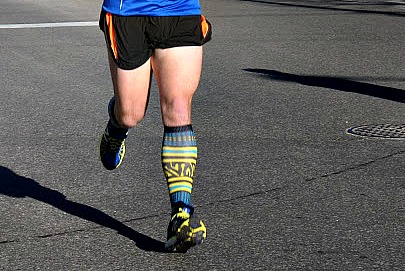Heel strike running increases work demand on the knee, resulting in knee cartilage injury overtime.
A study by Williams et al. (2000) reported that heel strike runners had greater work demand on the knee compared to forefoot runners because heel strike running increased stride length which resulted in a more anterior strike position at initial contact. The consequence of this is high braking forces with the body and the ground.
Why Runners Get Knee Cartilage Injury
The researchers also believe that because the calves are more passive in heel strike running, the knee becomes more extended at touchdown which increases loads on the knee-joint.

In another study, Williams et al. (2012) found that power absorption was highest in the knee in heel strike runners compared to forefoot strike runners, implying that the knee’s endure more force and stress in heel strike running. For that reason, we now know how knee injuries might stack up in heel strike running.
Overall, the results were not particularly surprising and supports the idea that the knee can derive a lot of injuries when power absorption is too high, which is why runners prone to knee injury are recommended to adopt forefoot running.
Heel Strike Running Giving More Ways for Runners to Injure
The fragile position of the knee-joint in heel strike running suggests that heel strike running is not the norm for human running. In contrast, habitual forefoot runners who run barefoot, like our ancestors, do not typically suffer knee pain because they actually handle work demand differently. This is because most barefoot runners land with a forefoot strike.
Why Forefoot Running is Better for Your Knees
In forefoot running, the knee-joint is unperturbed at initial contact because it is bent, not completely straight as it is in heel strike running. As a result, much of the impact in forefoot running redistributes away from the knee to the ankle where power absorption is the highest as it should be.
Essentially, the growing literature suggests that forefoot running offers hope for runners who struggle with knee injury. By emphasizing knees flexion and relaxation during forefoot running, would reduce forces transmitted to the knee.
Click here to see exactly how a proper forefoot strike looks like.
More From Run Forefoot:
What is Proprioception and Why We Need it to Run
Importance of Hip and Knee Flexion in Forefoot Running
Running Shoes for Forefoot Strikers
References:
Williams DS, McClay IS, & Manal KT. Lower extremity mechanics in runners with a converted forefoot strike pattern. J Appl Biomech. 2000;16:210-218.
Williams et al. Changes in lower extremity movement and power of absorption during forefoot striking and barefoot running. IJSPT, 2014; 7(5): 525-532.
Bretta Riches
BSc Neurobiology; MSc Biomechanics candidate, ultra minimalist runner & founder of RunForefoot. I was a heel striker, always injured. I was inspired by the great Tirunesh Dibaba to try forefoot running. Now, I'm injury free. This is why I launched Run Forefoot, to advocate the health & performance benefits of forefoot running and to raise awareness on the dangers of heel striking, because the world needs to know.
Latest posts by Bretta Riches (see all)
- Does Foot Strike Really Matter in Running? YES! - 17/04/2024
- Heel Lifts Increase Injury in Runners - 16/04/2024
- Are Minimalist Shoes Good for Seniors? YES! - 14/04/2024


Leave a Reply